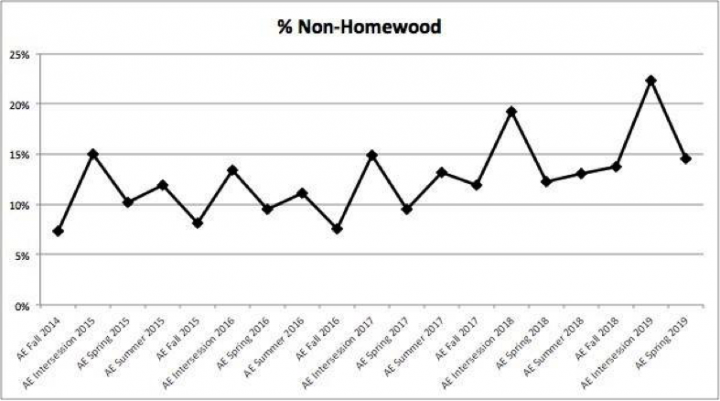Johns Hopkins UniversityEst. 1876
America’s First Research University
The rigid demarcation between undergraduate and graduate education is increasingly anachronistic. Johns Hopkins professional schools are a valuable resource, not available at all our peer institutions. They should be readily accessible to our undergraduates.
Faculty from other schools teach infrequently at Homewood, but the numbers are increasing, as demonstrated in Figure 4.11. In the Fall of 2014 7% of undergraduate courses were taught by non-Homewood faculty; five years later, in Spring 2019, 15% percent were taught by non-Homewood faculty. The percentage during the summer unsurprisingly is higher, ranging from 12 to 13% between 2015 and 2018. The scarcity of online undergraduate course options and lack of infrastructure for high quality distance education provision exacerbates the geographic boundaries between Homewood and the professional school campuses. Undergraduates should have access to the full breadth of talent represented in the University’s faculty. Barriers between Hopkins campuses should be lowered.

Several recommendations in this report provide opportunity for broader incorporation of all Johns Hopkins University faculty in the undergraduate experience. For example, faculty from the professional schools could teach in the first year seminar series. They could also partner with Homewood faculty to innovate team-based, interdisciplinary problem-solving courses. Recently, SAIS faculty began offering undergraduate courses in strategy and statecraft as well as international economics as complements to existing International Studies courses using an inter-campus, hybrid delivery model that could be emulated by other professional schools.
As part of this recommendation, the Commission urges that all Johns Hopkins students (assuming adequate pre-requisites and qualifications) be permitted to pursue programs leading to bachelor/professional master’s (3+2 or 4+1) degrees. Our primary intent, however, is not to establish new joint or dual degree programs. Nor is it to do what is already possible in many cases, namely, for students to seek a master’s degrees in their undergraduate majors. Rather it is to encourage students to explore advanced study and potential careers, regardless of major, across the University. The Commission imagines combinations that may not be possible or easily possible today; the Computer Science major who pursues a master’s degree in International Studies at SAIS, the History major who takes courses at the Carey school, or the Physics major who pursues a master’s in Biomedical Engineering. The implementation of this recommendation would not only serve our students well, and provide faculty at the professional schools additional opportunities to instruct and mentor undergraduates, but would serve our ongoing “One University” initiative.
First Destination survey data from 2018 data tells us that approximately 35% of our students pursue graduate school immediately after graduation. Not all of those students matriculate into JHU programs, but the Whiting School of Engineering and Bloomberg School of Public Health are the top two graduate schools of choice. In fact, 22% of graduating Engineering students and 6% of Arts and Sciences students take advantage of the opportunity to remain for a fifth year to acquire a Master’s degree at the Whiting School.
Several of our peer institutions offer co-terminal degree programs. Emory provides a series of 4+1 options, and Stanford has a robust co-terminal degree program available across nearly 50 programs. Their co-terminal degree program allows undergraduates to study for a Master of Arts or Master of Science degree while completing their bachelor’s degree(s) in the same or a different department. Admitted co-terminal students must have a minimum of one quarter overlap between their undergraduate and graduate degree programs in order to qualify. Harvard has an advanced standing program that allows selected students in some departments to apply for a fourth-year master’s degree.
Implementation of this recommendation will require buy-in from our professional divisions. The Provost should direct every division of the University to demonstrate that they have both individual courses and master’s programs in place open to Hopkins undergraduates from as broad a range of undergraduate majors as is reasonably possible, ensuring that financial assistance be available so that access to these programs is available to all qualified students. The existence of these programs would then be advertised directly to undergraduates while advisors would help direct students to them. In addition, the creation of online undergraduate courses, with distance education classrooms at each of the Johns Hopkins’ campuses, should be actively pursued.